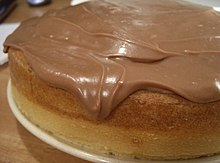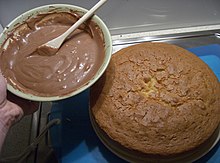Icing (food)



Icing, often called frosting in the United States,[1] is a sweet, often creamy glaze made of sugar with a liquid, such as water or milk, that is often enriched with ingredients like butter, egg whites, cream cheese, or flavorings. It is used to cover or decorate baked goods, such as cakes or cookies. When it is used between layers of cake, it is called filling.
Icing can be formed into shapes such as flowers and leaves using a pastry bag. Such decorations are commonplace on birthday and wedding cakes. Chef's color dye (food coloring) is commonly added to icing mixtures to achieve the desired color. Sprinkles, coloring mist, edible ink designs, or other decorations are often used on top of icing.
The simplest icing is a glacé icing, containing powdered sugar and water. This can be flavored and colored as desired, for example, by using lemon juice in place of the water. More complicated icings can be made by beating fat into powdered sugar (as in buttercream), by melting fat and sugar together, by using egg whites (as in royal icing), and by adding other ingredients such as glycerin (as in fondant). Some icings can be made from combinations of sugar and cream cheese or sour cream, or by using ground almonds (as in marzipan).
Icing can be applied with a utensil such as a knife or spatula, or it can be applied by drizzling or dipping (see glaze), or by rolling the icing out and draping it over the cake. The method of application largely depends on the type and texture of icing being used. Icing may be used between layers in a cake as a filling, or it may be used to completely or partially cover the outside of a cake or other baked product.
History
Covering cakes with powdered sugar or other materials were introduced in the 17th century.[2] The icing was applied to the cake then hardened in the oven. The earliest attestation of the verb 'to ice' in this sense seems to date from around 1600,[3] and the noun 'icing' from 1683.[4] 'Frosting' is first attested in 1750.[5]
See also
- Royal icing, egg white and sugar
- Fondant, heated water and sugar, sometimes with stabilizers like gelatin
- Ganache, chocolate and cream
- Marzipan, ground almonds and sugar
- Cake decorating
- Couverture chocolate, a high cocoa butter chocolate
- Powdered sugar
- Buttercream
References
- ^ Oxford English Dictionary, Third Edition, s.v. 'frosting' 3.a
- ^ Lynne Olver. "The Food Timeline: cake history notes". foodtimeline.org.
- ^ Oxford English Dictionary, 3rd edition, 2012, s.v.
- ^ Oxford English Dictionary, 3rd edition, 2012, s.v.
- ^ Oxford English Dictionary, 3rd edition, 2012, s.v.
